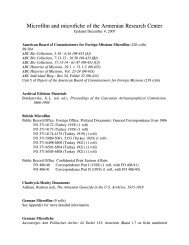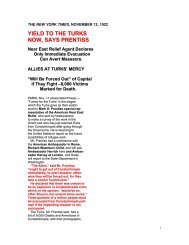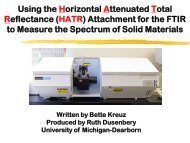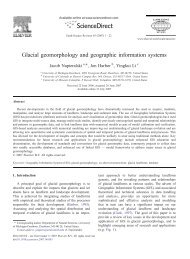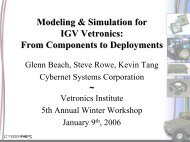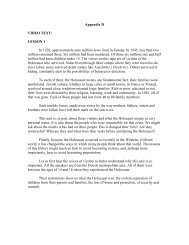Introduction to On Board Diagnostics (II)
Introduction to On Board Diagnostics (II)
Introduction to On Board Diagnostics (II)
You also want an ePaper? Increase the reach of your titles
YUMPU automatically turns print PDFs into web optimized ePapers that Google loves.
Catalyst Efficiency Moni<strong>to</strong>r: There are three types of catalysts: pellet (bead), ceramic monolith, and metal monolith. They differin the method by which they support the noble metals which convert exhaust gases <strong>to</strong> HC and NOx free gases. Three-waycatalytic converters typically contain platinum, and/or palladium, along with rhodium as catalytic materials. The term three-way refers <strong>to</strong> the ability of the converter <strong>to</strong> simultaneously oxidize HC and CO and reduce NOx. . Catalyst converters operateefficiently within a prescribed temperature range when placed at proper location in the exhaust gases’ path. Operation attemperatures which exceed the recommended maximums may cause irreversible damage <strong>to</strong> the catalyst, and components of theconverter. Since unburned fuel in<strong>to</strong> the converter can cause catastrophic astrophic failure, misfire detection is a must for safe converteroperation. Misfire detection is described previously. Converter also must have an over temperature detection algorithm <strong>to</strong>detect excessive temperature in the converter. This is done by decreasing dthe A/F ratio’s lambda value <strong>to</strong> less than 1. Thisalgorithm cannot work for coastdown conditions or overrun conditions. Therefore Deceleration fuel cu<strong>to</strong>ff c(DFCO) is sued <strong>to</strong>control catalyst temperature during vehicle coastdown, , when the engine intake manifold pressure is drive <strong>to</strong>o low <strong>to</strong> allow acomplete combustion. To prevent unburned fuel from entering the converter, the fuel injec<strong>to</strong>rs are shut off by the enginecontroller. Spark advance is filtered and thresholds are set <strong>to</strong> control <strong>to</strong>rque reversal ”bump” while still protecting the converter.The catalyst moni<strong>to</strong>r evaluates the converter efficiency as mandated by the OBD <strong>II</strong> <strong>to</strong> ensure that the catalyst is cleaning up theexhaust gases and reducing emissions from the exhaust gases. The diagnostic evaluates the oxygen s<strong>to</strong>rage capacity of theconverter by comparing the signal output of the post-converter oxygen sensor with the pre-converter oxygen sensor. According<strong>to</strong> EPA regulations, a catalyst is regarded as malfunctioning when n the average hydrocarbon conversion efficiency falls between50 and 60%. The diagnostic system is required <strong>to</strong> detect when the hydrocarbon emission (HC) concentration of the catalyst(closest <strong>to</strong> the engine ) is more than 40 <strong>to</strong> 50% of the engine-out emission concentration. The check is performed with the vehicleoperating at between 20 and 50 miles/hr with the speed held at a reasonably steady state condition. The output signal waveform of the oxygen sensor (lambda sensor) ,at the front end of the tconverter close <strong>to</strong> the engine, oscillates between lean and richvalue of 100 millivolts and 900 millivolts due <strong>to</strong> closed-loop loop control strategy that keeps the Air/Fuel ratio at s<strong>to</strong>ichiometry(lambda value equal <strong>to</strong> 1). For a converter whose oxygen s<strong>to</strong>rage e capacity is good, the output of the oxygen signal at the far end eof the converter should be flat, without any oscillation. This is due <strong>to</strong> the converter’s ability <strong>to</strong> s<strong>to</strong>re oxygen when the gas is lean(and rich in oxygen) and give up oxygen when the gas is rich (and d short of oxygen). This characteristic enables the oxidation ofhydrocarbons and the reduction of NOx in the exhaust gas simultaneously. The diagnostic consists of measuring mthe averageripple in the output signal wave form of the oxygen sensor at the e far end of the converter and comparing the ripple with asimilar oscillation at the input signal wave form of the oxygen sensor at the near end (closest <strong>to</strong> the engine) of the converter. Ifthe difference is above a value that corresponds <strong>to</strong> more than 60% 6converter efficiency then the converter efficiency isconsidered good. As a second check the catalyst temperature at the <strong>to</strong>utlet is moni<strong>to</strong>red and compared <strong>to</strong> the catalysttemperature at the input <strong>to</strong> the converter. If the catalyst is functioning properly, it creates an exothermic reaction resulting in ahigher outlet catalyst temperature. But this is not always reliable. The sensitivity of the outlet gas temperature <strong>to</strong> catalystefficiency may be <strong>to</strong>o low <strong>to</strong> reliably detect the difference at the t60% HC conversion efficiency level.Signal characteristics from the oxygen sensors for fresh, degraded, ed, and failed catalysts are explained in detail in a later section.The misfire detection diagnostic which is previously described is an important preventive measure that protects the converterfrom extreme temperature spike that can severely reduce converter r efficiency or even cause catalyst destruction al<strong>to</strong>gether.Catalyst converter diagnostics are described in more detail in a later section.



